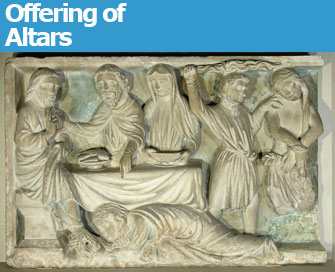 |
| “Le Repas chez Simon et la Flagellation du Christ” (Bourgogne, 1230-40) © Ville de Semur- en-Auxois/Christophe Gilles |
How many people avoid the Louvre, that museum of museums, just because it is so big, crowded and overwhelming? When taken in small bites, however, it can be quite manageable, and one of its current exhibitions …
 |
| “Le Repas chez Simon et la Flagellation du Christ” (Bourgogne, 1230-40) © Ville de Semur- en-Auxois/Christophe Gilles |
How many people avoid the Louvre, that museum of museums, just because it is so big, crowded and overwhelming? When taken in small bites, however, it can be quite manageable, and one of its current exhibitions offers the perfect excuse to pay a visit, if one were needed. Let the hordes of camera-clacking tourists stream toward the Mona Lisa while you calmly wend your way to the Richelieu Wing to take in the beautiful little exhibition “Les Premiers Retables” (through July 6).
The first altarpieces appeared around the year 1000. With the Christian mass increasingly being said in front of the altar, the decorations on it were no longer visible to the congregation, so artists began creating sculpted pieces to be placed on top of or above the altar. Sculpture eventually gave way to painting, an evolution documented in this show, which offers a selection of around 50 works dating from the 12th to early 15th century, most of them from France.
The first room of the show alone is worth the visit. It begins with a fascinating mid-12th-century wooden sculpture of the Virgin and Child from the Auvergne, with much of its polychrome decoration still intact. Stiff yet graceful, the Virgin sits regally, one hand holding the mature-looking Christ Child, who is smiling enigmatically, on her lap. Her expression has a mesmerizing effect that exudes a Buddha-like feeling of peace and acceptance.
You won’t want to stop looking at her, but move along to the next, equally stunning, work, one of the oldest known altarpieces, dating from the same period but from the Ile-de-France. The Virgin, larger than the figures flanking her, reigns supreme in the center, holding the Christ Child. The lateral scenes depict the Annunciation and the baptism of Christ, and the decorative carvings on the sides show grotesque creatures representing the struggles of life on earth, while the city carved along the top represents the heavenly Jerusalem humans must aspire to.
This first room also contains a rare surviving early-12th-century gilded altarpiece (most of those made with precious materials were stolen or melted down over the centuries), representing the Pentecost, with the 12 apostles, grouped in panels two by two, receiving the flames of the Holy Spirit, surmounted in a tympanum by Christ. This is one of several works in the exhibition that show a surprising level of expressiveness and movement not expected in such early pieces.
The show also includes several exquisitely detailed carved ivory pieces. No. 12, for example, a polyptych dating from the first half of the 14th century, depicts the Virgin and Child and scenes from the life of the Virgin. A gorgeous group of ivory sculptures (nos. 29-33) from later in the century includes a depiction of the Virgin stretching in a seductive pose. No. 39, a triptych from early-14th-century Paris, shows scenes from the whole life of the Virgin in highly expressive miniature carvings.
Among this small group of treasures, you’ll also find some gory scenes of martyrdom, including a finely carved mid-13th-century stone altarpieces showing Saint Hippolyte being subjected to a variety of indignities before being ripped apart by two horses running in opposite directions and finally ascending to heaven, assisted by two angels.
Musée du Louvre: Richelieu Wing. Métro: Palais Royal-Musée du Louvre. Tel.: 01 40 20 53 17. Open 9 a.m.-6 p.m., until 10 p.m. on Wednesday and Friday. Admission: €9 (€6 after 6 p.m. on Wednesday and Friday). Through July 6. www.louvre.fr
Buy related books and films from the Paris Update store.
More reviews of current art exhibitions.
Reader reaction
Click here to respond to this article (your response may be published on this page and is subject to editing).
© 2009 Paris Update
Favorite